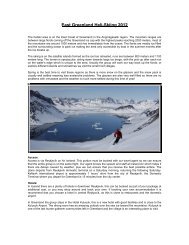Fibre-reinforced Composite Resin Bridges
Fibre-reinforced Composite Resin Bridges
Fibre-reinforced Composite Resin Bridges
Create successful ePaper yourself
Turn your PDF publications into a flip-book with our unique Google optimized e-Paper software.
Day TWO<br />
Managing the Worn Dentition<br />
What strategies are required as patients and their restored dentitions age?<br />
Restoration of an extensively worn or badly broken down dentition can be complex, costly and time<br />
consuming to implement. Because of its complexity and cost, this treatment is often delayed until it becomes<br />
essential.<br />
Dentists (and patients!) want to stop the repeat restoration cycle and its ongoing costly restorative burden. So<br />
how do we treat the patient with a severely broken down dentition?<br />
Through lectures, clinical demonstrations and participation exercises, Professor Meyers will present four steps<br />
to restorative success:<br />
Clinical evaluation of patients<br />
• Review of a number of patient cases<br />
• Risk assessment tools<br />
• Impact of patient’s health and lifestyle<br />
• Correct treatment planning prior to restoration<br />
Oral environment<br />
• How dry mouth and salivary acidity correlates with severe tooth wear and non-carious tooth surface<br />
loss<br />
• Examination requirements, salivary analysis and remineralisation strategies<br />
• Stabilisation of the oral environment and risk reduction prior to restoration<br />
New materials and techniques<br />
• How to evaluate the range of materials and techniques available for cost-effective and conservative<br />
management; and aesthetics<br />
• Step by step procedures (using a range of materials) to allow participants to compare the various<br />
materials and techniques for direct and semi-direct restorations<br />
Practical experience<br />
• Demonstration and participant simulation exercises covering techniques for the restoration of the<br />
worn dentition; including direct restorative techniques, laboratory procedures, direct, semi-direct and<br />
indirect adhesive technologies<br />
About the presenter:<br />
Professor Ian Meyers<br />
BDSc, FICD, FADI, FPFA, FRACDS<br />
Ian Meyers is currently in general dental practice in Brisbane, Australia and has honorary professorial positions<br />
with The University of Queensland School of Dentistry, and James Cook University School of Medicine and<br />
Dentistry. He is also currently the President of the Queensland Branch of the Australian Dental Association.<br />
Following his graduation from The University of Queensland in 1982 he spent a number of years in private<br />
practice and government dental clinics. Ian then commenced working for The University of Queensland in<br />
1988 and was the inaugural Colgate Chair of General Dental Practice from 2001 – 2009, and Chief Dental<br />
Officer for Queensland Health from 2009 – 2010. He has been involved in a wide variety of research projects in<br />
the applied dental biomaterials area and has run many postgraduate and continuing education courses on<br />
diagnosis and conservative management of tooth wear. He is a product consultant to a range of dental<br />
companies and is chairman of the ADA Dental Instruments, Materials and Equipment Committee. He is a<br />
member of the International Association for Dental Research, Chairman of the Australian Dental Research<br />
Foundation Research Advisory Committee and on the Board of Directors for the Australian Dental Research<br />
Foundation. In addition he is a member of the editorial board of The Australian Dental Journal and several<br />
other international journals. His major interests include adhesive restorative dental materials, diagnosis and<br />
management of the worn dentition and teaching and clinical development in general practice dentistry.









